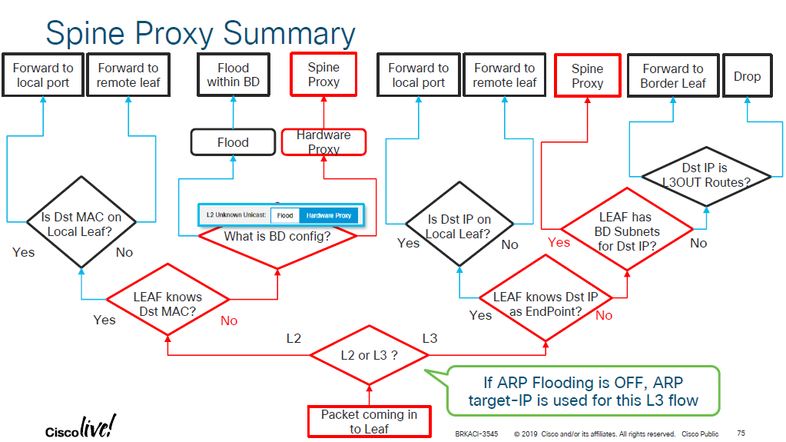- Cisco Community
- Technology and Support
- Data Center and Cloud
- Application Centric Infrastructure
- ACI Routing Decision Logic
- Subscribe to RSS Feed
- Mark Topic as New
- Mark Topic as Read
- Float this Topic for Current User
- Bookmark
- Subscribe
- Mute
- Printer Friendly Page
- Mark as New
- Bookmark
- Subscribe
- Mute
- Subscribe to RSS Feed
- Permalink
- Report Inappropriate Content
08-03-2021 11:03 AM - edited 08-03-2021 11:06 AM
Hello Community,
I have been looking for information about the routing decision on ACI.
There are 3 lookup points:
1- Endpoint Table
2- RIB Table
3- ARP Table.
Basically a leaf switch will look for an endpoint on its database, if it is not found, then it tries its RIB table and finally the ARP table if needed. That's what I got, so far so good.
My struggle comes from the fact that also as per the documentation, when a leave switch does not know how to get to a destination, it sends the traffic to a spine (which in theory should know about all endpoints or try to "discover" them) and the spines forward the traffic then to the final leave.
So:
Q1: When exactly in the 3 steps logic, does the leave send the traffic to the spine for lookup (COOP)?
Q2: If the leave uses the RIB info to route traffic to and endpoint, I guess that afterwards the leave will learn that endpoint and it wont have to get to the RIB next time it needs to send traffic to that endpoint? Is that how it works?
Q3: All routing decision are tied to VRFs as I understand, so for example if I ping an endpoint from a leave, which VRF am I using?
Thank you community team!
Solved! Go to Solution.
- Labels:
-
ACI App Center
Accepted Solutions
- Mark as New
- Bookmark
- Subscribe
- Mute
- Subscribe to RSS Feed
- Permalink
- Report Inappropriate Content
08-04-2021 05:26 AM
The answer as usual, it depends, but here is a flowchart which can help you understand a bit the routing decision:
Q1: can be simply answered following the flowchart above. Just as an informative note, in the RIB the APIC will program the BD subnet as static route with next hop to Spine Proxy.
Q2: It depends. If you have enabled IP data-plane learning in the BD (enabled by default) then yes, the leaf will learn the source IP of the endpoint from data plane packets; otherwise, will learn local IPs are learned from ARP/GARP/ND via the control plane.
Q3: You must specify the VRF in which you are pinging:
Leaf201# show vrf
VRF-Name VRF-ID State Reason
SD:SD 7 Up --
black-hole 3 Up --
overlay-1 4 Up --
Leaf201# iping -h
usage: iping
<snip>
[ -V <vrf-name> name of the VRF through which destination is reachable ]
</snip>
Leaf201# iping 10.1.1.1 -V SD:SD
Stay safe,
Sergiu
- Mark as New
- Bookmark
- Subscribe
- Mute
- Subscribe to RSS Feed
- Permalink
- Report Inappropriate Content
08-04-2021 05:26 AM
The answer as usual, it depends, but here is a flowchart which can help you understand a bit the routing decision:
Q1: can be simply answered following the flowchart above. Just as an informative note, in the RIB the APIC will program the BD subnet as static route with next hop to Spine Proxy.
Q2: It depends. If you have enabled IP data-plane learning in the BD (enabled by default) then yes, the leaf will learn the source IP of the endpoint from data plane packets; otherwise, will learn local IPs are learned from ARP/GARP/ND via the control plane.
Q3: You must specify the VRF in which you are pinging:
Leaf201# show vrf
VRF-Name VRF-ID State Reason
SD:SD 7 Up --
black-hole 3 Up --
overlay-1 4 Up --
Leaf201# iping -h
usage: iping
<snip>
[ -V <vrf-name> name of the VRF through which destination is reachable ]
</snip>
Leaf201# iping 10.1.1.1 -V SD:SD
Stay safe,
Sergiu
- Mark as New
- Bookmark
- Subscribe
- Mute
- Subscribe to RSS Feed
- Permalink
- Report Inappropriate Content
08-04-2021 07:38 PM - edited 08-04-2021 07:44 PM
Thank you @Sergiu.Daniluk, that flow chart clarified a lot the routing/forwarding decision, more than the "3 steps" process.
I actually had no idea that spine proxy can be used for both L2 and L3 decisions. For some reason I only though of it as the last resource for L2 forwarding decision.
Thank you for the answer !!
Discover and save your favorite ideas. Come back to expert answers, step-by-step guides, recent topics, and more.
New here? Get started with these tips. How to use Community New member guide




